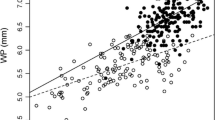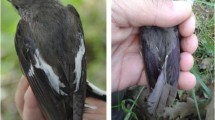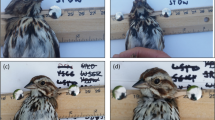Summary
We tested the hypothesis that the basis of the variation in reproductive strategy among male yellow warblers (Dendroica petechia) is a tradeoff in the allocation of reproductive effort to intrasexual competition (territorial effort) and to parental care (parental effort). Since a negative correlation between level of parental effort and amount of brown streaking on the breast (plumage score) has already been demonstrated in this species, this study looked for evidence of a positive correlation of territorial effort with plumage score and a negative correlation with parental effort. Analysis of the spatial and temporal use of territories, prior to egg-laying, by males with different plumage scores supported the prediction that brighter (higher plumage score) males allocate more effort to territorial establishment and maintenance (Fig. 1). Male plumage score was positively and highly significantly correlated with six different measures of the relative amount of time spent, rate of energy expended, and risk of injury assumed by each male during territorial activities. The level of territorial effort was also found to be negatively correlated with the level of parental effort expended by the same males later in the season, confirming that there is a tradeoff in allocation of reproductive effort to these two major components. Further analysis revealed that territory quality was positively correlated with male plumage score (Figs. 3 and 4), while average nestling growth rate and other indices of reproductive success were not (Fig. 6). These results suggest that increased territorial effort by brighter males enables them to occupy higher quality territories where high levels of parental effort are not necessary to maintain high levels of reproductive success. Since reproductive success was not correlated with plumage score, this study further supports the differential allocation hypothesis that different males are using alternative strategies for the allocation of reproductive effort.
Similar content being viewed by others
References
Alatalo RV, Lundberg A (1986) The sexy son hypothesis: data from the pied flycatcher Ficedula hypoleuca. Anim Behav 34:1454–1462
Biermann GC, Sealy SG (1982) Parental feeding of nestling Yellow Warblers in relation to brood size and prey availability. Auk 99:332–341
Brown JL (1975) The evolution of behavior. Norton, New York
Brown JL, Orians GH (1970) Spacing patterns in mobile organisms. Ann Rev Ecol Syst 1:239–262
Carpenter FL, MacMillen RE (1976) Threshold model of feeding territoriality and test with a Hawaiian honeycreeper. Science 194:639–642
Charnov EL, Orians GH, Hyatt K (1976) Ecological implications of resource depression. Am Nat 110:247–259
Davies NB, Houston AI (1984) Territory economics. In: Krebs JR, Davies NB (eds) Behavioural ecology. Sinauer, Sunderland, pp 148–169
Ettinger AO, King JR (1980) Time and energy budgets of the willow flycatcher (Empidonax traillii) during the breeding season. Auk 97:533–546
Gill FB, Wolf LL (1975) Economics of feeding territoriality in the golden-winged sunbird. Ecology 56:333–345
Krebs JR (1982) Territorial defence in the great tit (Parus major): do residents always win? Behav Ecol Sociobiol 11:185–194
Kurland JA, Gaulin SJC (1984) The evolution of male parental investment: effects of genetic relatedness and feeding ecology on the allocation of reproductive effort. In: Taub DM (ed) Primate paternalism. Van Nostrand Reinhold, New York, pp 259–308
Myers JP, Connors PG, Pitelka FA (1979) Territory size in wintering sanderlings: the effects of prey abundance and intruder density. Auk 96:551–561
Pitelka FA (1959) Numbers, breeding schedule, and territoriality in pectoral sandpipers in Northern Alaska. Condor 61:233–262
Pyke GH, Charnov EL, Pulliam HR (1977) Optimal foraging: a selective review of theory and tests. Quart Rev Biol 52:137–154
Ricklefs RE (1967) A graphical method of fitting equatio to growth curves. Ecology 48:978–983
Stearns SC (1976) Life-history tactics: A review of the ideas. Quart Rev Biol 51:3–47
Studd MV (1987) Alternative strategies for the allocation of reproductive effort in male yellow warblers. PhD thesis, Queen's University, Kingston, Canada
Studd MV, Robertson RJ (1985a) Sexual selection and variation in reproductive strategy in male yellow warblers (Dendroica petechia). Behav Ecol Sociobiol 17:101–109
Studd MV, Robertson RJ (1985b) Evidence for reliable badges of status in territorial yellow warblers (Dendroica petechia). Anim Behav 33:1102–1113
Studd MV, Robertson RJ (1989) Influence of age and territory quality on the reproductive behaviour of male yellow warblers. Can J Zool (in press)
Trivers RL (1972) Parental investment and sexual selection. In: Campbell BG (ed) Sexual selection and the descent of man, 1871–1971. Aldine, Chicago, pp 136–179
Wade MJ (1979) Sexual selection and variance in reproductive success. Am Nat 114:742–747
Wade MJ, Arnold SJ (1980) The intensity of sexual selection in relation to male sexual behavior, female choice, and sperm precedence. Anim Behav 28:446–461
Wittenberger J (1981) Animal social behavior. Duxbury Press, N. Scituate
Author information
Authors and Affiliations
Rights and permissions
About this article
Cite this article
Studd, M.V., Robertson, R.J. Differential allocation of reproductive effort to territorial establishment and maintenance by male yellow warblers (Dendroica petechia). Behav Ecol Sociobiol 23, 199–210 (1988). https://doi.org/10.1007/BF00302943
Received:
Accepted:
Issue Date:
DOI: https://doi.org/10.1007/BF00302943




